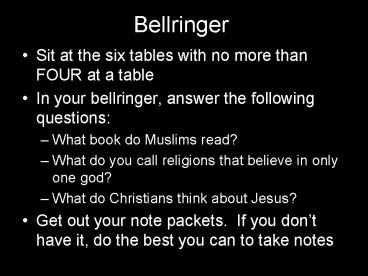Bellringer - PowerPoint PPT Presentation
1 / 46
Title: Bellringer
1
Bellringer
- Sit at the six tables with no more than FOUR at a
table - In your bellringer, answer the following
questions - What book do Muslims read?
- What do you call religions that believe in only
one god? - What do Christians think about Jesus?
- Get out your note packets. If you dont have it,
do the best you can to take notes
2
Buddhism
3
Buddhism the teachings of the awakened one
(Gautama Buddha).
4
Age
- Buddhism is one of the oldest religions in
practice today. - It was founded in 500 BC.
5
People who follow Buddhism are called Buddhist.
6
Where are Buddhist?There are about 708 million
7
Expansion of Buddhism between 1st-10th century CE
8
Core Beliefs
- Strive to put an end to the stress of existence
- A Buddha is any person who discovers the true
nature of reality - Want to have an understanding of the true nature
of all things
9
Central Figure Gautama Buddha
10
Rebirth and Karma
- Lives can be in any of a large number of states
of being, including those of humans, any kind of
animal, and several types of supernatural beings.
11
Your type of rebirth is dependent on your Karma
actions of the body, speech and mind.
12
Six realmsincludes rebirth as a deva, an asura,
a human being, an animal, a hungry ghost, or a
being in Naraka (hell).
13
Four Noble Truths
- Birth, aging, illness, death, ect. Are all
suffering - Suffering is caused by a craving for existence
and things. - Suffering ends when a person stops wanting an
existence and things. - You can end suffering by following the noble
eight fold path.
14
Right Mindfulness
Right Concentration
Right Speech
Noble Eightfold Path
Right View
Right Effort
Right Action
Right Livelihood
Right Intention
15
(No Transcript)
16
Nirvana
- The extinguishment of all desires
17
The Middle Way
- Avoiding all extremes
- Practicing
- moderation
- this is the path to Nirvana
18
Bhikku a Buddhist monk
19
(No Transcript)
20
People who follow Hinduism are called Hindus.
21
Where are Hindus?
22
Hinduism is a set of religious traditions and not
a single well-defined religion.
23
Hinduism is one of the oldest religions in the
world.
24
Hinduism is the third largest religion in the
world with over 1 billion followers.
25
Some Hindus practice polytheism a belief in or
worship of more than one god.Other Hindus
practice henotheism a devotion to one god while
accepting the existence of others.
26
Brahman
- Brahman is the supreme god of all gods. An
eternal supreme spirit which can take many forms
or manifestations of the thousands of gods. - Reveals himself in three ways
27
1 Brahma the creator of the world
28
2 Vishnu preserver of the world
29
3 Shiva destroyer of the world
30
Hindus also believe in many smaller gods called
Devas.
31
Basic Beliefs
- 1 Dharma natural law or reality the way of the
higher truths. This is an ideal - way of life.
32
Basic Beliefs
- 2 Samsara a great revolving door between life
and death (reincarnation)
33
Basic Beliefs
- 3 Karma a sum of all that an individual has
done, is currently doing and will do (actions)
34
Basic Beliefs
- 4 Moksha release from reincarnation (salvation)
by following one of four paths (yogas)
35
Four Pursuits of life
- Moksha liberation from reincarnation
- Dharma righteousness
- Artha wealth
- Kama pleasure and love
36
Religious Text called the Vedas
37
Yoga integration of body, mind a spirit union
with the divine
38
Aum represents Brahman
Swastika purity
39
(No Transcript)
40
Tilaka a mark symbolizing faithalso worn by
married Hindu women may be used to identify
which tradition is followed
41
Hindus worship in Temples
42
Hindus worship in Temples
43
(No Transcript)
44
Denominations (divisions)
- Hinduism is divided into four major divisions
- Vaishnavism, Shaivism, Shaktism, and Smartism.
45
Conversion
- Hindus do not actively recruit new members
- (also called evangelizing).
46
Hindus believe that the goals of spiritual life
can be attained through any religion, so long as
the religion is practiced sincerely.






























